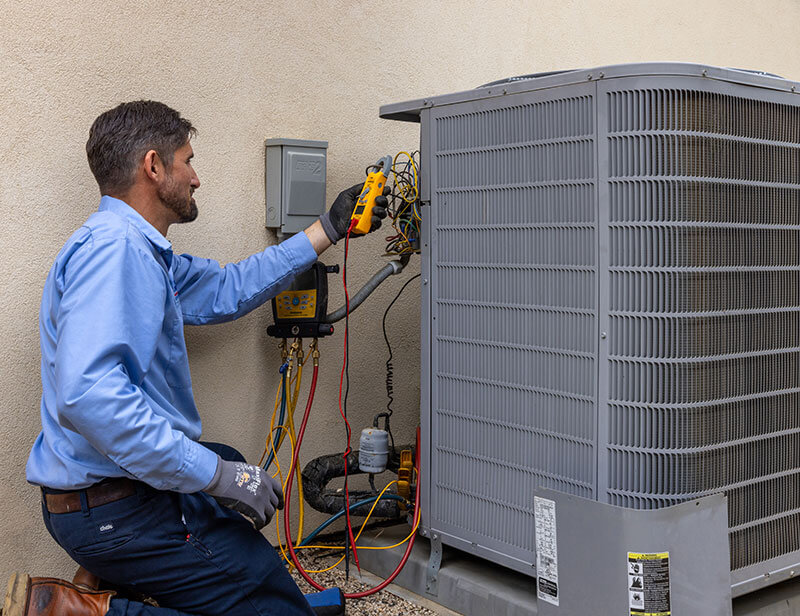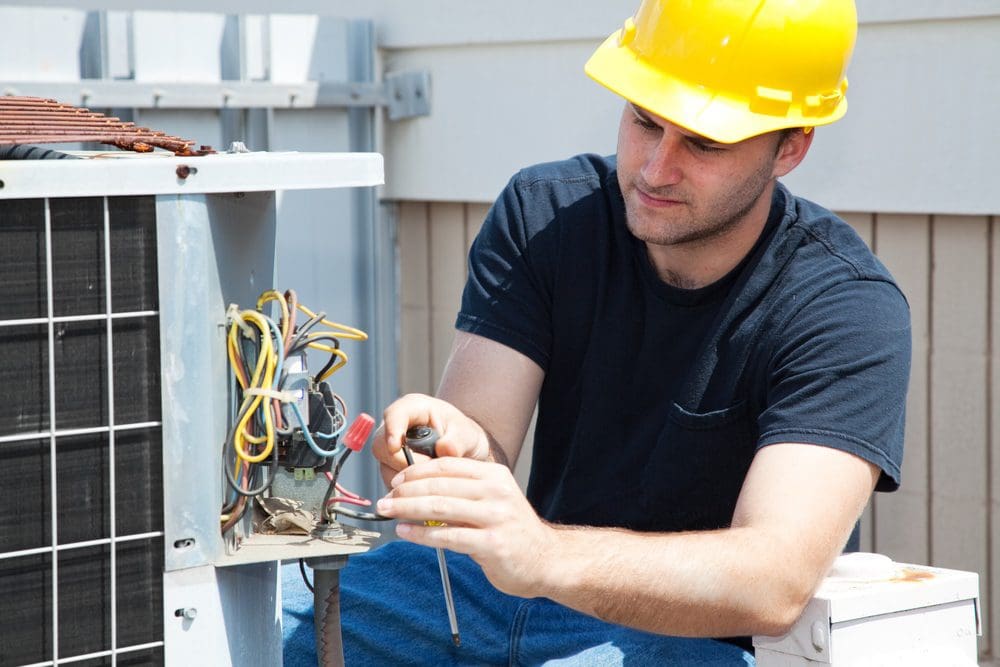Seasonal Reasons for heat pump installation ooltewah tn
Seasonal Reasons for heat pump installation ooltewah tn
Blog Article
How a Heatpump and Furnace Interact to Maximize Your Home's Home heating Effectiveness
Understanding how a heatpump and furnace work with each other is vital for house owners seeking effective home heating solutions. Each system has its strengths, providing a well balanced strategy to home comfort. The heatpump masters moderate temperature levels, while the heater delivers quick warmth throughout extreme cold. This harmony not only lowers energy prices however also improves the lifespan of both devices. What aspects influence this partnership, and how can homeowners maximize their advantages?
Understanding Warmth Pumps: How They Work
Although many people might be not familiar with their inner operations, heatpump play a crucial role in modern-day home heating systems. These gadgets run by moving heat from one location to one more, using the principles of thermodynamics. In cooler months, a heat pump extracts warm from the outdoors air, ground, or water, and transfers it inside to warm the living area. Conversely, during warmer months, it can reverse the procedure, acting as an air conditioning system by expelling warm from inside to the outside.Heat pumps are composed of an evaporator, condenser, growth, and compressor valve. The refrigerant within the system takes in warm as it vaporizes at reduced temperatures and stress. The compressor then boosts the pressure and temperature of the refrigerant, permitting it to launch heat as it condenses. This effective process can considerably lower energy intake contrasted to traditional heating techniques, making heatpump a sustainable selection for climate control in homes.
The Function of Heating Systems in Home Home Heating
Furnaces play an essential role in home heating by giving a trustworthy resource of warmth during the colder months. They operate by generating warmth through burning or electrical resistance, dispersing it throughout the home by means of ducts or radiant systems. The performance of a heater is often gauged by its Yearly Fuel Utilization Efficiency (AFUE) ranking, which suggests how effectively the device transforms fuel right into heat.Furnaces can use various power resources, including natural gas, oil, lp, or electricity, permitting property owners to choose one of the most suitable choice for their needs. Unlike warmth pumps, which may have a hard time in extreme chilly, heaters preserve consistent performance, ensuring that interior temperature levels stay comfy regardless of outside problems. Furthermore, modern-day furnaces usually come furnished with innovative modern technology, such as variable-speed blowers and wise thermostats, improving their effectiveness and responsiveness. This flexibility makes heaters an important element in all-encompassing home heating strategies.

Benefits of Using Both Equipments Together
Integrating the toughness of both heating systems and warm pumps can cause an extra effective and effective home heating remedy. Utilizing both systems enables property owners to make the most of the warm pump's power efficiency throughout milder temperature levels while relying on the heating system for more severe cold conditions. This double method can greatly reduce energy prices, as heatpump consume much less electricity than traditional home heating methods when temperature levels are moderate.Additionally, utilizing both systems together can improve convenience degrees in the home. Warm pumps can give regular, also heating, while furnaces can quickly increase ambient temperature levels when needed. In addition, the integration of both systems can expand the life-span of equipment by minimizing wear and tear on each unit, as they share the workload. Inevitably, property owners can enjoy a well balanced, cost-effective heating solution that adjusts effortlessly to varying weather, making sure a cozy and inviting home throughout the cold weather.
Just How Heat Pumps and Furnaces Enhance Each Various Other
They develop a complementary home heating system that maximizes efficiency and comfort when home owners integrate warm pumps and heaters. Warmth pumps run by moving heat from the outdoors air or ground, making them very effective in moderate environments. They stand out during milder temperatures, providing cost-effective heating. On the other hand, furnaces produce warmth with burning or electrical resistance, supplying strong, immediate heat during extreme chilly conditions.The mix of these two systems enables dynamic changes based upon temperature changes. Throughout warmer months or milder winter season days, the heat pump can take the lead, conserving energy and decreasing expenses. As temperatures drop, the furnace can seamlessly engage, guaranteeing regular heat throughout the home. This synergy not only maximizes energy usage however likewise improves the lifespan of both systems, as each device operates within its optimal efficiency variety. Together, they develop a balanced atmosphere that adapts to differing environment needs.
Enhancing Efficiency: Tips for Homeowners
Home owners can improve their home heating efficiency with a number of useful techniques. Establishing a regular upkeep timetable, incorporating wise thermostat modern technology, and implementing efficient insulation and sealing options are crucial actions. These procedures not only boost convenience but additionally lower energy prices.
Regular Maintenance Schedule
To ensure maximum heating effectiveness, establishing a normal maintenance routine is important for any home. House owners should focus on regular examinations of both heatpump and furnaces to establish peak efficiency. This includes altering air filters each to three months, as clogged filters can greatly minimize efficiency. Additionally, organizing professional upkeep at the very least annually enables specialists to recognize and address prospective issues prior to they rise. Property owners must additionally clean up the warm pump's exterior unit to stop debris accumulation that can prevent airflow. By adhering to a regular maintenance routine, home owners not just improve their heater' efficiency however likewise prolong their lifespan, resulting in higher convenience and reduced energy prices throughout the chillier months.
Smart Thermostat Combination
Incorporating a clever thermostat into a click for source home heater can considerably improve energy performance, especially as it enables accurate control over temperature setups. These tools can find out the home owner's routine and choices, immediately adjusting the temperature level to maximize convenience while minimizing power use. They can lower home heating during times when the home is vacant, minimizing unnecessary intake. Numerous clever thermostats additionally offer real-time power usage data, allowing property owners to make enlightened decisions about their heating practices. In addition, remote gain access to via smart device applications allows individuals to adjust settings from anywhere, making certain the home is cozy upon return. In general, clever thermostat integration not only boosts convenience but substantially contributes to power savings and effectiveness.
Insulation and Securing Solutions
Smart thermostats play an essential duty in energy effectiveness, yet their efficiency can be substantially enhanced by appropriate insulation and sealing remedies. Property owners need to prioritize insulating walls, floors, and attic rooms to decrease heat loss. Premium insulation products, such as spray foam or fiberglass, can greatly enhance thermal resistance. In addition, securing gaps around air ducts, windows, and doors prevents chilly air infiltration and warm getaway. Weatherstripping and caulking work approaches for attending to these leaks - heat pump replacement ooltewah tn. Regular evaluations for air leaks, together with the usage of blower door tests, can help determine trouble locations. By buying insulation and securing, homeowners can optimize the performance of their heater, ultimately bring about reduced energy usage and reduced utility expenses
Usual Misconceptions Regarding Warm Pumps and Furnaces
What misconceptions border heatpump and furnaces? Many individuals incorrectly believe that warm pumps are ineffective in chillier environments. In truth, modern-day heat pumps are developed to operate effectively even in low temperature levels, offering dependable home heating throughout winter months. An additional typical misconception is that heaters are always more reliable than warm pumps. However, this relies on the particular energy resources and efficiency rankings of the units in inquiry. Some may likewise think that using both systems simultaneously is unneeded, but actually, this mix can maximize home heating effectiveness, particularly during severe climate condition. Furthermore, people usually think that warmth pumps call for continuous upkeep, when in reality, they have similar upkeep needs to typical furnace. By debunking these misconceptions, home owners can make more educated choices regarding their heating alternatives, eventually causing enhanced comfort and power effectiveness in their homes.
Upkeep Factors To Consider for Combined Systems

Regularly Asked Concerns
Can Warm Pumps Job Effectively in Exceptionally Cold Climates?
Heatpump can battle in incredibly chilly environments due to minimized performance and heat extraction restrictions. Advancements in technology have led to designs made for far better performance in such conditions, enhancing their practicality in extreme atmospheres.
For How Long Do Heat Pumps and Furnaces Commonly Last?
Heatpump usually last 15 to two decades, while furnaces have a life expectancy of 15 to three decades. Normal upkeep can expand their longevity, making sure efficient procedure and lowering the requirement for early substitutes.

What Is the Average Price of Setting Up Both Systems?
The typical price of installing both a warmth pump and a furnace commonly ranges in between $5,000 to $10,000 - furnace replacement. Factors influencing this price include system size, installment complexity, and regional labor prices
Are There Tax Motivations for Using Energy-Efficient Heating Equipments?
Many home owners ask about tax obligation motivations for energy-efficient furnace. Different government and state programs typically check these guys out supply rebates or credit scores, encouraging the adoption of sustainable innovations to lower power consumption and promote environmental obligation.
Just how Do I Choose the Right Size Heatpump and Heating System?
Picking the appropriate dimension heatpump and furnace involves determining the home's square video footage, taking into consideration insulation top quality, and evaluating local climate. Consulting a professional can ensure optimal system efficiency and power effectiveness based on particular requirements. ductless mini splits. Understanding how a heat pump and heater job with each other is crucial for home owners looking for reliable heating services. In colder months, a heat pump removes warmth from the outdoors air, ground, or water, and transfers it inside your home to warm the living room. When home owners incorporate warm pumps and furnaces, they create a corresponding home heating system that makes best use of performance and comfort. Heat pumps operate by moving warm from the outside air or ground, making them highly reliable see this in moderate climates. Warmth pumps can have a hard time in incredibly cold environments due to lowered performance and warmth removal limitations
Report this page